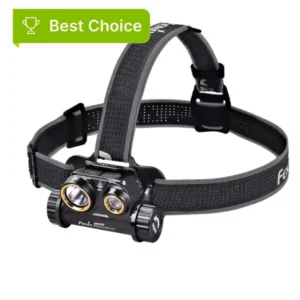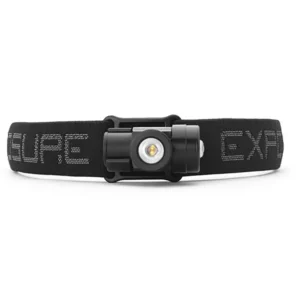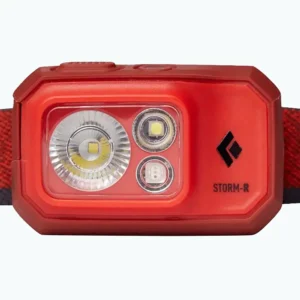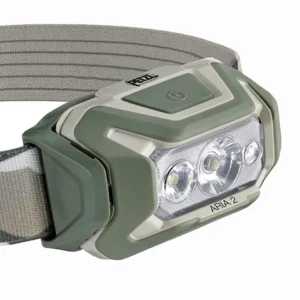0330 off the southeast coast of Africa and fast asleep in the warm cocoon of my bunk but aware that things were not right on deck. There is always that moment when your mind tries to convince you that things are ok and to get back to sleep, but the sailor in you has to overrule it. In this case fast, as the noise – a mixture of crashes and whip-like sounds – from on deck was awful. Jumping into my foulies, boots and lifejacket, I climbed up on deck and into the howling gale. The wind and rain in the air took my breath away and, bracing myself against the coaming, I gathered my thoughts. A headsail had come loose in the awful conditions and its metal clew was alternately dragging in the water and crashing onto the deck. Each hit was taking a chunk out of the gel coat. Headlamp on and a fantastic red light helped me grab sail ties, inch forward, grab the sail and get it securely tied down. Once again, I thanked the heavens that I had the right equipment on hand when it was needed.
Having the right headlamp for sailing, especially when navigating at night, is crucial for safety, efficiency, and comfort. It is a rechargeable headlamp? Is it properly waterproof? They are an essential piece of my equipment. I’ve tried many over the years. Some are awful, some are expensive and some are just brilliant. Here’s a bit about night vision and my view, as a professional sailor, of the best options out there.
Night vision and adapting to darkness at sea
Darkness adaptation, or night adaptation, is the process by which the human eye adjusts to low light conditions after being exposed to bright light and gives the ability to see in the dark. The process involves both physiological and biochemical changes within the eye, primarily affecting the rod cells, which are the photoreceptor cells in the retina that are sensitive to low light levels.
Here’s how darkness adaptation works:
- Pupil Dilation: Initially, the pupils dilate to allow more light to enter the eye. This is a relatively quick response and is the first step in improving vision in dark conditions.
- Photopigment Regeneration: The retina contains two types of photoreceptor cells: rods, which are more sensitive to light and essential for night vision, and cones, which detect color and detail in bright light. In bright conditions, the photopigment (rhodopsin) in rod cells is broken down, rendering them less sensitive. When the light level decreases, rhodopsin regenerates, gradually improving the eye’s sensitivity to light. This regeneration process is what primarily drives darkness adaptation.
- Functional Adjustment: Over time, the eye shifts its reliance from cones to rods, as rods are more effective in low light. This transition isn’t immediate and can take up to 30 minutes or more for complete adaptation. During this period, the sensitivity of the eye to light can increase dramatically.
- Neural Adaptation: The visual system in the brain also adjusts to low light levels, processing the signals from the rods more effectively. This adjustment further enhances night vision.
Darkness adaptation is far from perfect. For instance, since rod cells are not concentrated in the central part of the retina (the fovea), which is responsible for sharp central vision, peripheral vision becomes more effective than central vision in very low light. This phenomenon is known as “night blindness” or scotopic vision, where people tend to see better in the dark by not looking directly at objects.
Why do sailors use red lights at night?
Here’s why red light is favoured:
- Minimal Impact on Rods: Rod cells are less sensitive to long-wavelength light, such as red light. Hence using red light minimizes the disruption of the dark adaptation process of the rod cells, allowing the eyes to remain adjusted to the dark.
- Photopigment Preservation: The photopigment rhodopsin, found in rod cells, is less sensitive to red light. This means that exposure to red light does not lead to significant bleaching of rhodopsin, preserving night vision. Other colors, especially blue or white light, can rapidly degrade rhodopsin and impair night vision.
- Contrast and Clarity: Red light offers the best compromise over blue lights and green lights for most tasks. It allows for sufficient illumination and contrast to perform tasks but without significantly impairing the ability to see in the dark.
Make sure your headlamp is waterproof
There is simply no point in having a headlamp for use at sea unless it’s properly waterproof. To ensure it is, you need to understand the IP ratings scale. Read our full guide here (it’s really useful to know for all sorts of tools and equipment on board) but suffice it to say, your headlamp needs to be IP67 at least
Understanding Lumen Count
Lumens are a measure of the amount of light emitted from a light source. The official measure of 1 lumen is something 10 times brighter than moonlight; To give you an idea, a standard flashlight emits about 17 lumens. When looking to choose your headlamp for sailing, don’t just look for the highest lumen count. If nothing else, the more lumens you have, likely the greater the weight, shorter run-time, and higher price. The number of lumens emitters also doesn’t tell you much about the actual light quality. The beam distance and the shape both define a light’s output more than the lumen number. Based on our experience at sea, we’ve found that around 300 lumens is a good output for most uses.
Our top five headlamps for sailors
Fenix HM65R ShadowMaster Headlamp
My current favourite headlamp. As I’ve got older, I need more light and this beast delivers 1400 lumens of white light and 150 lumens of red light which gives a range of 30 meters. It is a big unit, but it’s light and fits comfortably on my head. It has an IP68 rating, making it totally waterproof and recharged via a USB-C cable and the LED lights do their best to minimize battery drain.

Exposure Lights Raw Pro Head Lamp
Another superb headlamp. Not many headlamps are that well thought through. Why does the white light come on before the red light, for instance? Exposure has thought everything through. The red light comes on first. It has a good 75-lumen red light and a hefty 265-lumen white light. Its IP68 rating signifies it’s suitable for continuous immersion in water, and it’s USB-C rechargeable

Fenix HM65R
Known for its extremely high light output of 1400 lumens and a lightweight frame. It offers a remarkable range of up to 160 meters but has a limited battery life at its highest setting. Its durability and waterproof rating of IP68 make it a strong choice for sailors. I also find it a comfortable headlamp to wear for prolonged periods.

Black Diamond Storm 500R
A very versatile headlamp that would be a real asset to any sailor. It pumps out a hefty 500 lumens on full power white, but I like that as well as a red light setting, it also has blue light modes and a strobe mode. If ever you’ve been in the sea at night, hoping to attract attention, that strobe mode could be a lifesaver. It has excellent battery life, running on reserve for over 20 hours and at max beam for over six hours

Petzl Aria 2 RGB
Offers multiple color options for night vision, with white, red green and blue modes, 450 lumens and up to 100 hours of burn time. It is waterproof and a feature I like is that it is a dual fuel headlamp – ie it can use a rechargeable battery pack or shop-bought traditional batteries (aa batteries), giving it great flexibility even though I don’t like to carry extra batteries most of the time.